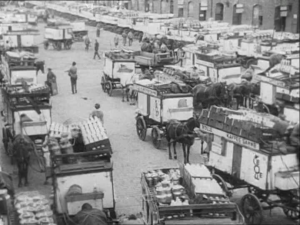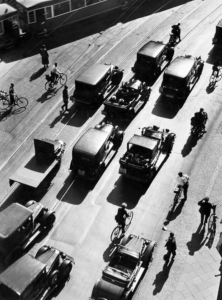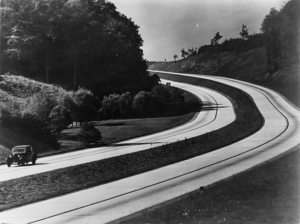Building a Concept
Understanding “Horseless”
After a stuttering following the Great War, the slow economic recovery began. Even in Germany, where the financial situation was uncertain in the best of times and catastrophic in the worst years, the number of cars and trucks rose during the 1920s. This increase in automotive travel was a social and cultural change that horsepower was now a historical artifact. But the existing roads were not suitable for this new kind of transportation nor were there enough roads to handle the growing demands of “traffic,” a new phenomenon that had to be handled. Ironically, it was not in America, the home of mass-produced cars, that a solution was created, but in the defeated and struggling nations of Germany and Italy that the idea of what would be called a “highway” or a “freeway” was born. As Richard Vahrenkamp wrote in The German Autobahn 1920-1945: Hafraba Visions and Mega Projects, “The deficits of the German Reich’s road system became obvious when it could not longer bear the increase in motor vehicle traffic. The number of registered motor cars in Germany rose quickly, tripling from 161, 000 in 1925 to 4433,000 in1929. The motor car steadily gained importance for business life in the 1920s..A significant increase in registered trucks can also be seen. The number of trucks rose in the 1920s at a significant growth rate of 22 per cent annually..trucks gained advantages over transportation by train in terms of speed and price..”
Behind these figures is, to the modern mind, how small or how low the numbers were in the 1920s, attesting the recentness of the decision on the part of society to accept cars and trucks over trains. And this increase in use was taking place under dire economic circumstances. In addition, as Vahrenkamp pointed out, was the new version of tourism–touring by car, rather than train. The existing country roads were not convenient for tourists and they were entirely unsatisfactory for moving goods from one site to another, as trucks and cars fought for space with herds of animals and inattentive pedestrians. To the unlikely duo of tourism and trucking it is necessary to add “landscape” into the mix of how Germany decided to solve its problems of how to get people and goods from one place to another in the modern twentieth century. Thomas Zeller linked the Teutonic regard for nature back to the eighteenth century and the discovery of the “picturesque landscape.” In his book, Driving Germany: The Landscape of the German Autobahn, 1930-1970, he wrote, “All participating social groups–from landscape architects and roadway engineers to journalists, landscape painters, novelists, and the users of the autobahn–mostly had landscape in mind when they spoke of the spatial consequences of the roads. Consciously or not, they were tapping into one of the most complex discourses of modernity.” The autobahn then was and is a Kulturalandschaft or a “cultural landscape.” Despite its links to the past, the highway was a totally new social condition, a symptom of larger cultural shifts and a predictor of a future that was over the horizon. But it was this unknown future that the Autobahn was built for.
An “autobahn” is precisely what it says it is–a road to be used exclusively for the automobile. We are so used to highways and freeways that it is rare that we wonder where the revolutionary idea of building a road exclusively for a car originated. The concept of a freeway, where the car and the motorist enjoys the freedom of an open road came from Germany. The first iteration of a “cars only” road was the Automobil-Verkehrs- und Übungsstraße, built between 1913 and 1921, was used exclusively for racing. There is a popular myth that the Autoban was a Nazi production, but that was not the case. The Nazis, early in their rise to political power, were opposed to the construction project. Autobahns, they declared, were be exclusively used by wealthy people and Jews, or, as the Nazis wrote, such roads would “only benefit rich aristocrats and Jewish big capitalists and their interests.” Certainly, middle and lower class people could not afford cars and, in the 1920s, automobiles were clearly a status symbol. In America, there was the Model T, which was designed to be affordable to the working class, but Germany had no such tradition of social equality. However, the Weimar Republic began a small Autoban project. The first road for normal, that is, not racing, cars was between Düsseldorf and Opladen in 1929, followed by an even more impressive attempt in 1932. The mayor of Cologne, Konrad Adenauer, understanding that his city had the worst traffic in the nation, constructed a twenty kilometer stretch between Cologne and Bonn to ease the problem. The speed limit was 120 kilometers, a fantasy futuristic number. Few cars could travel even half that speed, but the entire Autobahn was built on post-war hope and Republican dreams that existed even before the Great War.
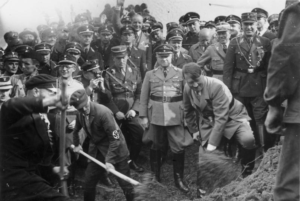
Hitler and Fritz Todt, behind and to the left, inaugurating the Reichsautobahn construction
The most ambitious plan put forward came after the Depression of 1929, the famous HaFraBa route which connected Hamburg to Basel via Frankfurt. The virtue of the project was that it guaranteed employment and that such a road would speed goods to market at a remarkable seventy-five kilometers an hour. When the Nazis came to power, they decided to take over the Autobahn as their project and renamed the Cologne-Bonn thoroughfare and started from scratch renaming the HaFraBa as the “Association for the Preparation of Reichsautobahns.” The Autoban was now officially named the “Reichsautobahn.” However, the Nazis needed to correct the problem they had previously stated–the road could not be for rich people, not under these populist socialists. Hitler admired Henry Ford and understood that, in the depth of the Depression, completing the Autoban and manufacturing a car for the people were be excellent public projects that could provide employment for over a million young men. For the Third Reich, these public projects not only solved the unemployment problem, they would also provide a future that could be built by the people themselves. Although Hitler certainly dreamed of his new highways as being arteries for the military, he presented the Autobahn as a civilian enterprise–something for the German people who would, therefore, need a “people’s car” to drive on this new road.
In 1937, Adolf Hitler asked Ferdinand Porsche to design a “Peoples’ Car,” like the Model T Ford that the people could afford to buy and drive. Named the “people’s car,” the Volkswagen was born, but despite the fact that we think of this now-beloved car as German, its design was in fact inspired by a remarkable car from Czechoslovakia. Even more ironic, the idea of a “people’s car” predated the Nazis and was the idea of a Jewish designer. Josef Ganz designed the first prototype as early as the 1920s and worked with a friend, an aeronautical engineer, Paul Jaray, who convinced him to think in terms of aerodynamics as the basis of his design. A Hungarian, Jaray had not only redesigned the old fashioned Zeppelin but also designed one of the first “streamlined: cars in 1921, which he describe as “The lower part of the body body has the form of a half streamline body and covers the chassis with the wheels, the engine compartment and the passenger compartment. The lower surface is even and runs parallel to the floor space. On this main part a substantially narrower streamline body is set, which is carried by a framework-like construction, which is developed on the chassis for its part.” When it came into limited production in 1922, it was named the the Ley T6. This car was revolutionary in its design and attracted a great deal of attention and was copied internationally by designers who had to pay Jaray for the privilege of using his inspirations.
But the only car of a Jaray design that came into production on Europe was the Tatra, of which more shall be written later. Jaray passed on his torch to Ganz, who had a different vision for the modern car, its modern design, and its modern purpose. Not only did Ganz build, test drive and showcase his “people’s car,” he also held patents on important elements of his automobile that improved its performance and made its safer to drive. In 1931, Ganz debuted the Maikäfer or “May Bug,” named after the month of its inception. Another word for “bug” is “beetle.” By 1933 Ganz was able to show off the People’s Car at the International Automobile and Motorcycle Exhibition in Berlin, which was opened by Hitler. It was at this exhibition that Hitler first saw the Peoples’ Car which was to be sold for an affordable one thousand Reichsmarks. Hitler promptly moved against the Jewish designer, attempting to assassinate him twice. Ganz fled to Switzerland and spent the rest of his life being wiped from history by the Nazis.
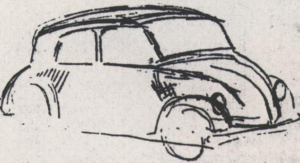
Sketch by Ganz for prototype “Volkswagen,”
supposedly given by Hitler to Ferdinand Porsche
The Autoban itself, like its Italian counterpart, was very basic by today’s standards. Probably because no understanding of the dangers of fast driving existed, there was no median strip nor were their shoulders on the Autoban. The Tatra, like the Volkswagen had a streamlined design from the mind of Hans Ledwinka and Paul Jaray. Just as Hitler was anxious to appropriate the concept of a Peoples’ Car, he was taken by the low curved design of the Tatra. The Tatra 77a and 87 were very fast cars, perfect for the Autobahn, and were greatly admired by Hitler. In 1934, Hitler asked Porsche to design a Nazi sponsored and backed “Peoples’ Car” for the new Autobahns. When the Volkswagens debuted in 1938, they looked suspiciously like the Tatras, even utilizing the rear engine. But, conveniently for Porsche, Germany had already invaded Czechoslovakia, and Mr. Porsche and his company avoided the consequences of their corporate copying until 1961.
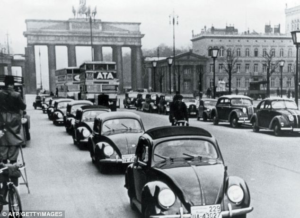
Early Volkswagens at the Brandenburg Gate in 1938
Aside from being the inspiration for the new Volkswagen, the Tatra had another reputation of being a killer of Nazi officers. Fancying themselves to be dashing and reckless, the officers charged up and down the new lanes of the highway at speeds of one hundred kilometers an hour. Unfortunately, the Tatra was badly engineered and handled badly, especially on curves where they would simply spin out of control. More Nazi officers died on the Autoban than in combat, so many that Hitler himself ordered that they stop driving the Tatra. The Allies considered the Autobahn their “secret weapon,” so tantalizing, so irresistible was the prospect of driving with no restraints that the officers kept on killing themselves.
As for the Volkswagen, the German people were required to purchase the future car through weekly payments symbolized by the weekly ritual of pasting a stamp into a book. When the book was filled, the citizen could pick up the purchased people’s car. If one missed a payment, the car vanished. In fact, the Volkswagen never really existed beyond some six hundred examples, none of which reached the waiting public. This car, Hitler proclaimed, “..is for the broad masses that this car has been built. Its purpose is to answer their transportation needs, and it is intended to give them joy.” In fact, the car itself was referred to as the “Strength-Through-Joy” car. The Second World War broke out and the manufacturing at the Gesellschaft zur Vorbereitung des Deutschen Volkswagens mbH switched from the small bug shaped cars to military armaments. Not one German ever received the car, the stamp books were never redeemed, and the people’s car project was postponed until the War was over.
The thirties was the golden age for streamlined cars which finally found the ideal surface to speed upon–the Autoban. American audiences did not see the vision of highways devoted to automobiles until Norman Bel Geddes introduced his “Futurama” at the 1939-1940 World’s Fair in New York. By then, war was looming and would begin in Europe in 1939, wiping out designs for consumers until the late 1940s. The era of “streamlining,” a word popularized by Bel Geddes spanned the 1930s. After a decade of gestation in terms of design and a three decades of Autoban construction, the new idea of what a car must look like–its definitive appearance–emerged. Over time, a distinctive aerodynamic shape emerged that is occasionally defied but remains supreme today. The fancy parts and accoutrements, which had once seemed so stylish in their display of elaboration, suddenly became superfluous, in the way, impeding the forward motion of the car. By the end of the decade of the 1920s, the spare tire disappeared into the trunk, the headlights receded and tucked themselves inward. Smooth and compact wing-like shapes, designed for the air to flow seamlessly over the roof of the automobile, became the prevailing design motif. In the process of determining what would make a car look swift and sleek and how to make driving an experience of unimpeded speed, the car became lower, losing height and settling closer to the ground. In considering the function—the vehicle moves through air—the form emerged. Out of Streamlined design, the modern car had arrived.
